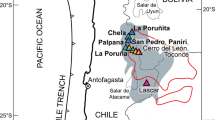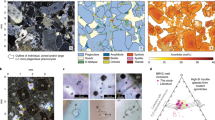Abstract
From the beginning of the study of Hawaiian volcanism there has been controversy over possible relationships between the neighbouring active volcanoes Mauna Loa and Kilauea1–5. Seismic activity, thought to reflect upward migration of magma, reveals that the magmatic plumbing systems apparently converge at depth to form a broad funnel within the mantle6. Although on rare occasions they have erupted concurrently, the brief historical eruptive record appears to show that when Kilauea is most active, Mauna Loa is in repose and vice versa, suggesting that they may be competing for the same magma supply5,7. Petrological, geochemical and isotope data, however, require a diametrically opposite conclusion. Distinct differences in major-element, trace-element and isotope compositions of lavas are regarded as compelling evidence that the two volcanoes have separate magmatic plumbing systems, supplied by parental magmas from physically and geochemically distinct mantle sources8–13. Here we present preliminary geochemical data which show that in the past 2,000 years Kilauea has erupted a spectrum of lava compositions resembling historical Kilauea lavas at one end and Mauna Loa lavas at the other. We discuss the cause of this diversity, and speculate that magma from Mauna Loa may have invaded Kilauea's 'high-level' magmatic plumbing system.
This is a preview of subscription content, access via your institution
Access options
Subscribe to this journal
Receive 51 print issues and online access
$199.00 per year
only $3.90 per issue
Buy this article
- Purchase on Springer Link
- Instant access to full article PDF
Prices may be subject to local taxes which are calculated during checkout
Similar content being viewed by others
References
Dana, J. D. Characteristics of Volcanoes 399 (Dodd, Mead Co., New York, 1890).
Dutton, C. E. US geol. Surv. 4th A. Rep. 75–219 (1884).
Daly, R. A. Proc. natn. Acad. Sci. U.S.A. 47, 47–122 (1911).
Jagger, T. A. Geol. Soc. Am. Mem. 21, 508 (1947).
Macdonald, G. A. & Abbott, A. T. Volcanoes in the Sea 441 (University of Hawaii Press, Honolulu, 1970).
Klein, F. W. J. geophys. Res. 87, 7719–7726 (1982).
Klein, F. W. J. Volcan. geotherm. Res. 12, 1–35 (1982).
Powers, H. A. Geochim. cosmochim. Acta 7 77–107 (1955).
Wright, T. L. US geol. Surv. Prof. Pap. 735, 39 (1971).
O'Nions, R. K., Hamilton, P. J. & Evenson, N. M. Earth planet. Sci. Lett. 34, 13–22 (1977).
Tatsumoto, M. Earth planet. Sci. Lett. 38, 63–87 (1978).
Leeman, W. P. et al. Am. J. Sci. 280A, 794–819 (1980).
Basaltic Volcanism Study Project Basaltic Volcanism on the Terrestrial Planets 1286 (Pergamon, Elmsford, New York, 1981).
Holcomb, R. T., Champion, D. E. & McWilliams, M. O. Bull. geol. Soc. Am. 97, 829–839 (1986).
Holcomb, R. T. US geol. Surv. Prof. Pap. 1350, 261–350 (1987).
Rubin, M., Lockwood, J. P. & Friedman, I. US geol. Surv. Prof. Pap. 1350, 209–243 (1987).
Wenz, K. P. thesis, Univ. Massachusetts (1988).
Powers, H. A. Pacif. Sci. 2, 278–292 (1948).
Decker, R. W. & Christiansen, R. L. Explosive Volcanism: Inception, Evolution and Hazards 122–132 (National Academy, Washington, DC, 1984).
Tilling, R. I., Wright, T. L. & Millard, H. T. Jr US geol. Surv. Prof. Pap. 1350, 641–689 (1987).
Easton, R. M. & Garcia, M. O. Bull. volcan. 43, 657–673 (1980).
Rhodes, J. M. J. geophys. Res. 88A, 869–879 (1983).
Rhodes, J. M. J. geophys. Res. 93, 4453–4466 (1988).
Chen, C-Y. & Frey, F. A. Nature 302, 785–789 (1983).
Stille, P., Unruh, D. M. & Tatsumoto, M. Nature 304, 25–29 (1983).
Roden, M. F., Frey, F. A. & Clague, D. A. Earth planet. Sci. Lett. 69, 141–158 (1984).
West, H. B. et al. Nature 330, 216–220 (1987).
Frey, F. A. & Roden, M. F. Mantle Metasomatism (eds Menzies, M. A. & Hawkesworth, C. J.) 423–463 (Academic, London, 1987).
Holcomb, R. T. et al. Geology 16, 400–404 (1988).
Malahoff, A. & Woolard, G. P. Pacif. Sci. 20, 265–311 (1966).
Flanigan, V. J. & Long, C. L. US geol. Surv. Prof. Pap. 1350, 935–946 (1987).
Author information
Authors and Affiliations
Rights and permissions
About this article
Cite this article
Rhodes, J., Wenz, K., Neal, C. et al. Geochemical evidence for invasion of Kilauea's plumbing system by Mauna Loa magma. Nature 337, 257–260 (1989). https://doi.org/10.1038/337257a0
Received:
Accepted:
Issue Date:
DOI: https://doi.org/10.1038/337257a0
This article is cited by
-
A mantle-driven surge in magma supply to Kīlauea Volcano during 2003–2007
Nature Geoscience (2012)
-
Opening wide the magma spigot
Nature Geoscience (2012)
-
Age, geology, geophysics, and geochemistry of Mahukona Volcano, Hawai`i
Bulletin of Volcanology (2012)
-
Magma storage and ascent during the 1995 eruption of Fogo, Cape Verde Archipelago
Contributions to Mineralogy and Petrology (2011)
-
Ferric/ferrous ratios in 1984 Mauna Loa lavas: a contribution to understanding the oxidation state of Hawaiian magmas
Contributions to Mineralogy and Petrology (2005)
Comments
By submitting a comment you agree to abide by our Terms and Community Guidelines. If you find something abusive or that does not comply with our terms or guidelines please flag it as inappropriate.



